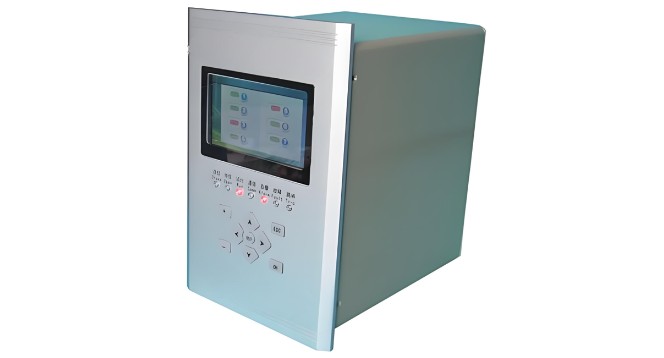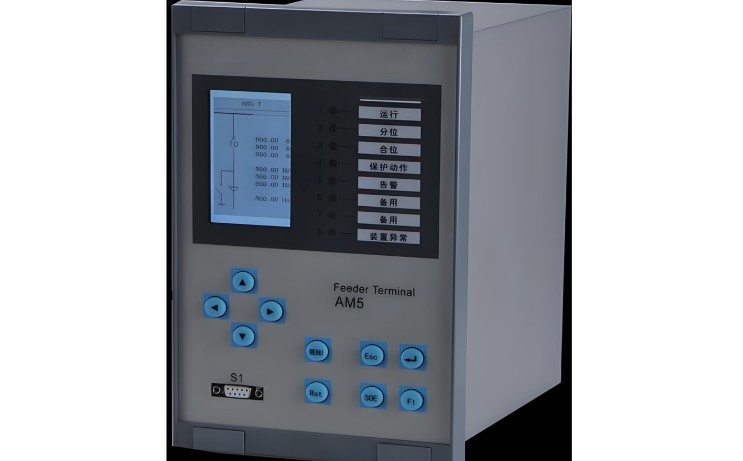1. Pilihin at Tungkulin ng mga Integrated Protection Device na Mikrokompyuter
1.1 Pilihin ang Integrated Protection Device na Mikrokompyuter
Upang siguraduhing tama at wasto ang pagganap ng integrated protection device na mikrokompyuter sa kanyang tungkuling relay protection, ang pagsusuri sa disenyo ay dapat kumonsidera nang komprehensibo ang reliabilidad, response time, maintenance at commissioning, at karagdagang mga function.
Ang input ng signal para sa integrated protection device na mikrokompyuter ay pareho sa tradisyonal na relay protection: ang mga signal ng voltage at current ay ipinasok mula sa potential transformers (PTs) at current transformers (CTs), inconvert ng transmitter sa mga standard na signal na kinakailangan ng protection device, in-filter upang alisin ang mga low- at high-order harmonics at iba pang interference, at in-convert mula analog to digital signals ng A/D converter.
Ang CPU ay nagkalkula sa digital input, nakikumpara ang resulta sa preset values, gumagawa ng paghahatol, at pagkatapos ay nagpapasya kung mag-trigger ng alarm o trip. Upang mapasatisfy ang mga requirement sa reliabilidad, ang mga measurement at protection input signals ay pinoproseso at in-output ng independent processing units sa loob ng device. Ito ay nagbibigay ng tama na accuracy sa measurement habang nagbibigay din ng sapat na margin sa mga severe faults. Ang general engineering reliability ay nasasatisfy kung ang device ay hindi nag-e-experience ng A/D overflow o saturation kapag umabot ang fault current sa 20 beses ang normal value.

1.2 Pilihin ang Response Time
Ang software workflow ng isang protection device ay karaniwang tulad ng ipinapakita sa larawan sa ibaba:
Makikita mula sa diagram na ang response time ng isang protection device ay malapit na nauugnay sa software na ginagamit at sa paraan ng calculation ng electrical quantity, na kadalasan ay hindi alam ng mga user.
Sa disenyo at pagsusuri, kami lamang makakapaghakbang sa kalidad ng isang protection device batay sa tatlong indikador: calculation accuracy, response time, at computational load. Ang tatlong ito ay may mutual conflict: mas mahina ang calculation accuracy at mas maliit ang computational load ay nagbibigay ng mas mabilis na response time, habang mas mataas na accuracy at mas malaking computational load ay nagbibigay ng mas mabagal na response. Sa pangkalahatan, para sa mga end-users ng power grid, ang pag-set ng computational load na mas malaki sa 3 beses, calculation accuracy na mas mataas sa 0.2%, at maximum response time na mas mababa sa 30ms ay sapat na upang mapasatisfy ang typical engineering requirements sa response time.
1.3 Pilihin ang Iba pang Mga Function
Ang mga integrated protection device ay naglalaman ng maraming integrated circuits, na nangangailangan ng mataas na teknikal na eksperto para sa maintenance. Sa pagsusuri, bigyan ng prayoridad ang mga device na modular at standardized hardware, na nagbibigay-daan sa hardware faults na ma-resolve sa pamamagitan lamang ng pagpalit ng modules, na nagpapataas ng work efficiency. Bukod dito, ang protection device ay dapat may built-in EPROM module, na nagbibigay-daan sa lahat ng setting values na ma-store digitally. Ang mga field personnel ay maaaring madaling i-recall ang mga settings na ito para sa equipment commissioning nang walang reprogramming.
Para ma-integrate sa buong project automation monitoring system, ang protection device ay dapat may communication capabilities, na nagbibigay-daan sa madaling network formation sa pamamagitan ng data buses at nagbibigay-daan para maipadala ang post-trip information sa upper-level automation monitoring system.
2. Relasyon ng Integrated Protection Devices at Plant-wide Automation Control Systems
Batay sa configuration at communication requirements ng plant automation control system, ang automation system para sa integrated protection devices na mikrokompyuter ay karaniwang nahahati sa tatlong layer: ang switchgear layer, substation layer, at central control room.
2.1 Switchgear Layer
Ang switchgear layer ay binubuo ng iba't ibang uri ng integrated protection devices na mikrokompyuter, direktang inilalapat sa switchgear. Bawat device ay direktang nag-handle ng mga measurement, protection signals, at control functions para sa kanyang respective cabinet. Ang mga specific functions ay sumusunod:
(1) Incoming Line Cabinet
Protection Functions: Instantaneous overcurrent, time-delayed overcurrent.
Measurement Functions: Three-phase current, three-phase voltage, active/reactive power, active/reactive energy.
Monitoring Functions: Circuit breaker open/closed position.
Control Functions: Manual open/close (on cabinet), remote open/close.
Alarm Functions: Trip due to accident, warning signals, open/close status, device fault, fault recording, etc.
(2) Transformer Cabinet
Protection Functions: Instantaneous overcurrent, time-delayed overcurrent, inverse-time overload, single-phase ground fault, heavy gas trip.
Measurement, Monitoring, and Control Functions: Same as incoming line cabinet.
Alarm Functions: Trip due to accident, light gas, temperature alarm, warning signals, open/close status, device fault, fault recording, etc.
(3) Busbar Cabinet
Protection, Monitoring, and Control Functions: Same as incoming line cabinet.
Alarm Functions: Trip due to accident, device fault, fault recording, etc.
(4) Motor Cabinet
Protection Functions: Instantaneous overcurrent, time-delayed overcurrent, overload, single-phase ground, undervoltage, overheating.
Measurement Functions: Three-phase current, three-phase voltage, active/reactive power, active/reactive energy.
Monitoring Functions: Circuit breaker open/closed position.
Control Functions: Manual open/close (on cabinet), remote open/close.
Alarm Functions: Trip due to accident, warning signals, open/close status, device fault, fault recording, etc.
Pagkatapos ng data acquisition sa kanilang respective switchgears, ang mga protection device ay nag-transmit ng data sa pamamagitan ng bus sa monitoring computer sa substation layer. Ang sistema na ito ay malaking nagbabawas ng control cables, nagbabawas ng on-site commissioning time, at nagpapataas ng work efficiency.
2.2 Substation Layer
Maraming signal mula sa substation na kailangang ilipat sa central control room sa pamamagitan ng industrial Ethernet ng planta, at ang mga control command mula sa central control room na kailangang tanggapin at ipadala sa mga protection device. Ang substation layer ay karaniwang binubuo ng industrial control computers, printers, at monitors. Ang kanyang pangunahing mga function ay kasama ang configuration at management ng switchgear protection devices, monitoring ng system operation, establishment at management ng database ng substation, at communication sa central control room.
Dahil sa confidentiality ng mga manufacturer sa software at electrical calculation methods ng kanilang protection devices, ang substation layer ay kailangang hawakan din ang communication protocol conversion upang mapabilis ang transmission at reception ng mga signal sa pagitan ng central control room at protection devices.
2.3 Communication Network
Ang communication sa pagitan ng switchgear at substation ay maaaring gamitin ang MODbus bus network, na sumusuporta ng hanggang 64 slave stations. Ginagamit ang optical isolation sa pagitan ng communication network at devices upang maiwasan ang external interference. Ang communication sa pagitan ng substation at central control room ay gumagamit ng industrial Ethernet na may fiber optic media, na may communication rate na mas mataas sa 1 Mbps.
2.4 Software
Ang system software ay maaaring gamitin ang mainstream platforms na may international standard architecture, tulad ng Windows NT. Ang software modules ay dapat kasama: master control software, graphics software, database management software, report generation software, at communication software.
Sa pagsusuri ng software, ang master control software ay dapat may mataas na degree ng modularity. Ang mataas na modularity ay nagbibigay-daan sa mga field personnel na tawagin ang software batay sa site conditions nang walang additional programming, na malaking nagbabawas ng operational at maintenance workload para sa dispatchers at maintenance staff at nagpapataas ng work efficiency.

3. Iba pang Konsiderasyon
Kasama pa rito, ang mga sumusunod na isyu ay dapat tandaan sa pagsusuri ng hardware para sa integrated protection devices na mikrokompyuter:
Gumamit ng sealed, reinforced enclosure na resistant sa strong vibration at interference, na may compact installation size, na suitable para sa harsh environments at panel mounting.
Gumamit ng industrial-grade dual-CPU structure, na bawat device ay naglalaman ng main CPU at communication CPU. Ang dalawang CPUs ay nagtrabaho sa mutual inspection mode upang mapataas ang response time at accuracy, maiwasan ang maloperation o failure to operate, at mapataas ang stability at reliability.
Full-range temperature automatic compensation na nagbibigay-daan sa device na mag-operate nang matagal sa environment na -20°C hanggang +60°C.
Ang measurement at protection signals ay pinoproseso nang hiwalay sa loob ng device, na nasasatisfy ang mga requirement sa accuracy at ang mga requirement para sa protection range at reliability.
Gumamit ng dedicated frequency sampling circuit upang makuha nang tama ang grid frequency, na nagpapataas ng accuracy ng calculation ng electrical quantity.
Gumamit ng optical isolation para sa digital input/output, at shielded cables para sa internal cabinet wiring, na effectively preventing external interference at nagpapataas ng anti-interference capability ng device.
Gumamit ng large-screen LCD display at soft keypad para mas malinaw na numerical display at mas madaling operasyon.
Pagkatapos ng commissioning at operation, ang iba't ibang protection setting values ay in-store digitally sa EPROM, na nagbibigay-daan sa immediate recall pagkatapos ng commissioning o circuit fault repair.
Equipped with a fully functional circuit breaker operating circuit, na suitable para sa kontrol ng iba't ibang uri ng circuit breakers, na nagpapadali ng substation retrofitting.
May comprehensive na accident analysis capabilities, kasama ang protection action event records, electrical quantity signal over-limit records, at fault recording.
4. Tungkulin ng Integrated Protection Devices na Mikrokompyuter sa High-Voltage Switchgear
Ang mga mikrokompyuter protection devices ay nagprotekta laban sa abnormal na kondisyon sa circuits. Ang kanilang mga tungkulin sa high-voltage switchgear ay kasama:
Ang mga mikrokompyuter protection devices ay may powerful na data processing, logical computation, at information storage capabilities, na may advanced na internal architectures. Ito ay nagbibigay ng complete na protection functions na katumbas ng conventional na relay protection. Sa pamamagitan ng pagtanggap ng mga signal mula sa mga measurement components tulad ng current at voltage transformers, ang device ay maaaring monitor, control, at protektahan ang estado ng circuit—tulad ng short-circuit protection, overload protection, at single-phase ground fault protection.
Kung wala ang mga protection devices, ang high-voltage switchgear ay gumagamit ng relays upang maabot ang mga protective functions. Ang modern na mikrokompyuter protection ay nagbibigay ng enhanced na functionality, tulad ng easy remote control, communication sa upper-level systems upang ilipat ang current, voltage, power, at energy data, at convenient adjustment ng protection settings.
























